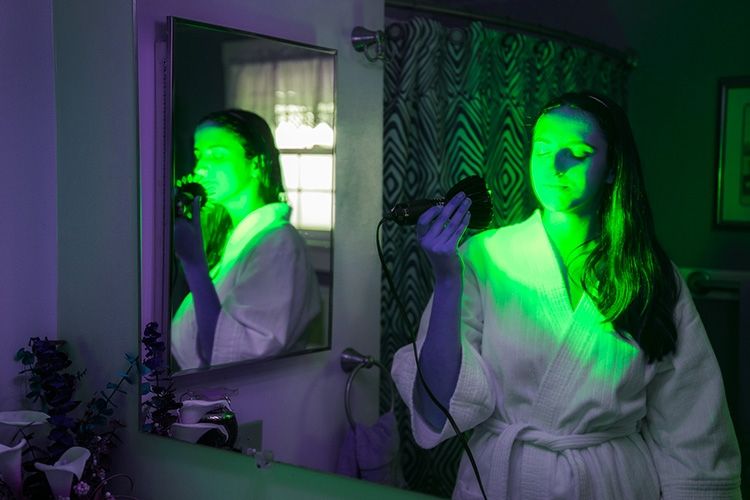The brain controls and regulates every physiological function in the body, connecting every organ and affecting every single  cell. The eyes are direct extensions of the brain, and while their most obvious role is in receiving and processing visible light, they also play other more subtle roles.
cell. The eyes are direct extensions of the brain, and while their most obvious role is in receiving and processing visible light, they also play other more subtle roles.
Certain nerves from the retina go directly to the pineal gland—the hormonal regulating center—as well as the pituitary gland, and the hypothalamus, which regulates deep brain processes. These nerves have nothing to do with color perception or vision; they simply connect the eyes directly with deep brain rhythms.
This pathway between the retina and the pineal gland is a very important one when it comes to regulating mood and emotion.
Regular exposure to dichromatic (also called “dichroic”) light is an effective modality for positively influencing this pathway in ways that help to reduce the negative impact of chronic stress, and to help the body shift toward greater balance and improved health.
Dichromatic bulbs (150 W PAR 38) seem to be the best choice for this simple and inexpensive self-care therapy. The acronym PAR stands for “Parabolic Aluminized Reflector” and refers to the metallic material inside the bulb, which filters and affects the color output of the lamp. The “38” designates the diameter, in one-eighth inch increments (a “38” is actually 4.75 inches in diameter).
Dichroic lighting employs internal interference filters to “separate” the energy radiating from the filament producing a specific color by selectively transmitting only the desired wavelengths of light, with virtually no heat absorption. It was originally used in the world of theater production, but over the decades, scientists in the photobiology world started to study it’s physiological properties, and developed ways to incorporate it therapeutically.
Dichroic bulbs look very similar to standard floodlight bulbs, but the bright aluminum coating found on the reflector surface is different. They generate pure, balanced colors of specific wavelengths; other unwanted wavelengths are reflected back into the lamp. The observed colors are richer and clearer. But these bulbs also produce wavelengths that activate non-visual brain pathways.
In contrast, standard, pigmented color bulbs merely create the illusion of color by frequency subtraction. They are not recommended for light therapy.
Deep brain structures and chemical pathways are positively affected with dichromatic light therapy and can help the body adapt toward improved health.
I recommend the green dichromatic light as the best overall color for routine use in self-care. Though other dichromatic colors like blue and amber are also effective, I find that green gives the most balanced ratio between red (warm, heating) and blue (cool) wavelengths. Green is also the preferred tone for pineal gland support.
I advise users to shine the light at a distance of 4 feet, and to simply sit in full exposure to this light for 20 minutes in the morning, and again in the evening. It is very safe, and dichromatic light like this is the only form of light therapy that can be used ad libitum.
Since the balancing effect we are trying to obtain is not dependent on vision per se, users can have their eyes closed or open. Blindness doesn’t matter either; visually impaired people can gain benefit from dichroic light exposure.
It does help to use these lights in a relaxed state, such as while meditating or taking a salt/soda bath. Obviously, it will not be nearly as effective if attempted in stressful or chaotic environments.
Many people are responsive to light and color. It’s why cloudy weather tends to evoke sad feelings or low-energy states, while sunshine quite the opposite. These are natural biological responses.
Light therapy for Seasonal Affective Disorder has been used for years and more research keeps coming in. But one need not be struggling with a diagnosed mood disorder in order to benefit from regular use of dichromatic green light. It can provide a subtle but powerful healing influence for anyone bogged down by stresses, or simply wanting to renew a deeper connection with him- or herself.
FURTHER READING
- How Seen Movement Appears in the Frog’s Optic Nerve, Federation Proceedings Vol. 18, No. 1, March; (with Maturana, Pitts, and McCulloch)
- What the Frog’s Eye Tells the Frog’s Brain, Proceedings of the IRE, Vol. 47, No. 11, November; (with Maturana, McCulloch, and Pitts). 1959.
- Color Medicine: The Secrets of Color / Vibrational Healing by Charles Klotsche, Light Tech Pub, 1993.
- Light Years Ahead: The Illustrated guide to full spectrum and colored light in mindbody healing by Brian Breiling & Bethany Argide, Celestial Arts, 1996.







